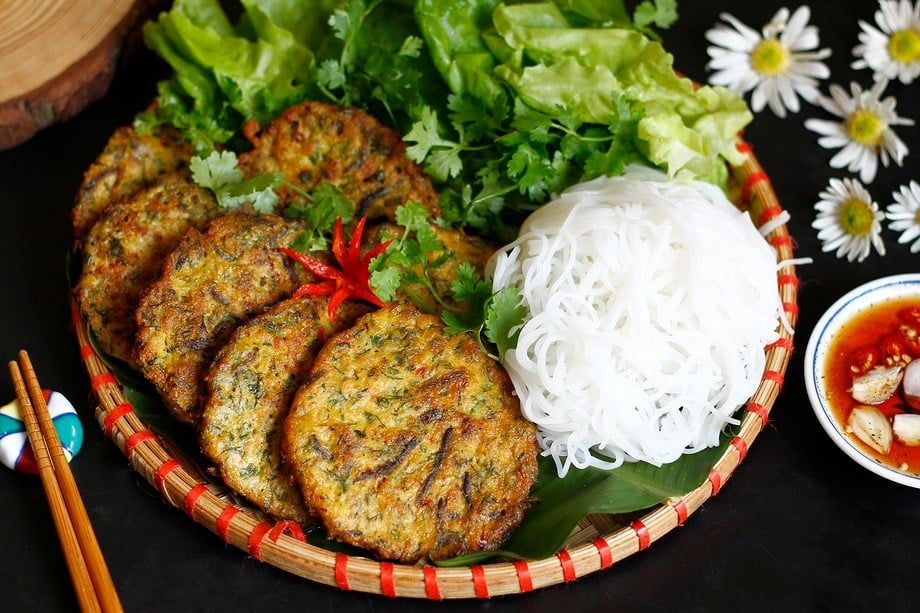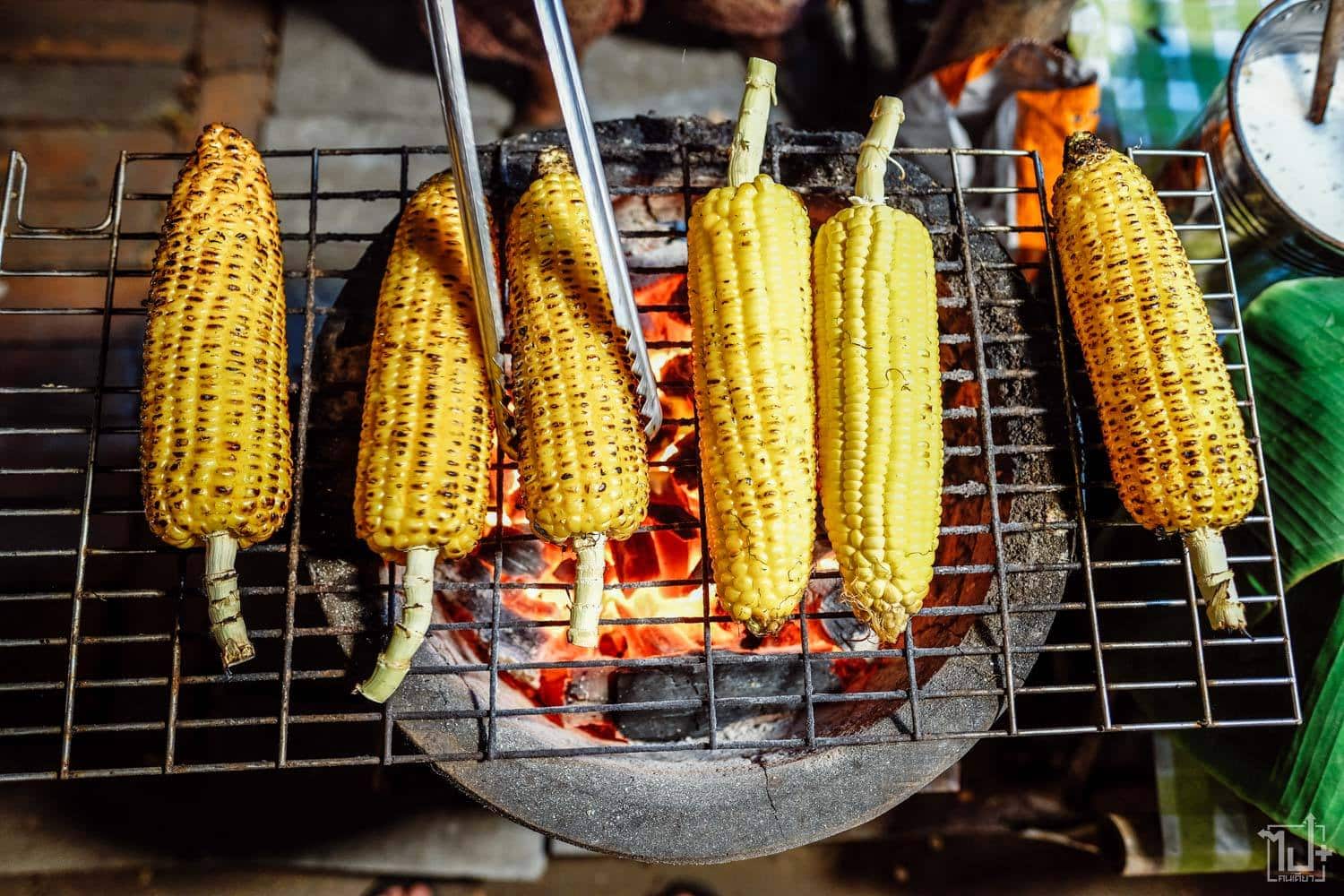As the chilly breeze blows back in town, young Hanoians’ minds are quickly filled with a series of noshes such as roasted sweet potatoes, hot sweet dessert soup or steamed snails.
These days, Hanoi is expecting a cold wave, with temperatures expected to drop sharply at night and in the early morning, fluctuating between 20 and 22 degrees Celsius. This is the ideal weather for diners to throw themselves into small roadside stalls and enjoy various steaming snacks with friends.
Here are some of the hot specialties that are a must when winter comes to the capital.
Floating cakes

Banh troi tau or floating cake has a sticky, chewy exterior of glutinous rice, wrapped in a fragrant mung bean or black sesame filling. The hot, slightly spicy ginger syrup gives diners a warm feeling, making it ideal for the cold weather.
As well as warming the heart, a bowl of banh troi tau is also a traditional culinary delight typical of Hanoi in the first windy days of the season. No one seems to mind sitting cramped on baby-sized plastic stools on a crowded street corner to enjoy these enchanting sweet, steaming treats at reasonable prices.
Suggested locations:
Pham Bang’s Banh Troi Tau: No. 30 Hang Giay Street, Hoan Kiem District
Che Bon Mua (Four-season Sweet Soup): No. 4 Hang Can Street, Hoan Kiem District
Ms. Diep Beo’s Banh Troi (Fat Diep’s Floating Cake): No. 52 Hang Dieu Street, Hoan Kiem District
Price: VND15,000-30,000/bowl or US$0.6 – $1.2
Hot cassava sweet soup

Che san, or hot cassava sweet soup, is one of the special winter noshes in Hanoi. A standard bowl features a gingery aroma, a not-too-sweet taste, and chewy, buttery cassava pieces mixed with soft tapioca starch. The soup is thick and golden brown in color. Each bowl of che san costs only around VND20,000 or $0.8, but the traditional taste of the dish is unforgettable to many.
This is a simple but ideal dish for chilly days. Some devotees even eat two or three bowls straight to satisfy their cravings. Che san is sold in many places across Hanoi, but the most delicious and authentic can be found on the streets of Ly Quoc Su and Luong Dinh Cua, particularly at small stalls on the sidewalk.
The seller of traditional cassava dessert soup on Ly Quoc Su Street said that she had been selling the stuff for more than 20 years. The fatty sweetness and steaming cassava attract many customers. Sometimes, her stall even appears on TV shows promoting Hanoi city’s culinary culture.
Suggested location: Sidewalk stalls on Ly Quoc Su Street (Hoan Kiem District) or Luong Dinh Cua Street (Dong Da District)
Price: VND20,000 or $0.8/bowl
Che ba cot or ginger syrup sweet soup with sticky rice

Che ba cot or ginger syrup sweet soup with sticky rice is a traditional sweet soup of the capital, known for its gentle sweetness, strong ginger aroma and smooth sticky rice. The soup is served with mung bean sticky rice to enhance the richness and chewiness. This sweet soup is often sought after on winter days for a warm, pleasant feeling.
Suggested location: Xoi Che Ba Thin, 1 Bat Dan Street, Hoan Kiem District
Price: VND20,000 or $0.8/bowl
Corn and sweet potatoes grilled over charcoal fire

Grilled corn and sweet potatoes are a typical, unmissable snack when the city enters the last season of the year. The golden corn on the cob and sweet potatoes grilled over charcoal emit an irresistible aroma that wafts through the sidewalks and neighborhoods. As rustic as they are, these noshes are loved by all types of diners – even the most discerning.
Suggested locations: Sidewalk stalls around Hoan Kiem Lake and Old Quarter Area.
Price: VND10,000-30,000 or US$0.6 – $1.2 for a cob or a sweet potato
Hot snails, steamed clams

When the windy cold winter arrives, it’s the best time for one of the Hanoi specialties snails. The popular food of the hard-shell mollusk, which lives in muddy areas such as ponds or rice fields, becomes attractive and tasty dishes when prepared by talented chefs. when being prepared by talented chefs.
Hot snails are a popular snack in Hanoi, especially on cool evenings. Snails are often prepared in a variety of ways, including boiling, stir-frying in tamarind sauce or with coconut, grilling with scallion oil, steaming with lemongrass and so on.
Each of the cooking methods produces a unique flavor. While boiled snails retain their natural sweetness and have a lemongrass fragrance, snails stir-fried in tamarind sauce have a harmoniously sweet-and-sour taste. Snails stir-fried with coconut have a buttery flavor, and those grilled with scallion oil are extremely fragrant.
The accompanying dipping sauce is often an elaborate blend of shredded ginger and lemongrass, sliced chili and garlic, as well as lime juice, which adds an unforgettable flavor.
Suggested locations: Oc Nong Ha Trang (Ha Trang’s Hot Snails): 1A Dinh Liet Street, Hoan Kiem District; Oc Hong Lai (Hong Lai’s Snails): 109B1 Tran Huy Lieu Street, Ba Dinh District; Quan Oc Lan Beo (Ms. Lan’s Snails): 2B Dang Van Ngu Street, Dong Da District.
Price: VND50,000-150,000 or $2 to $6 per serving depending on the type and cooking method
Quay nong or hot fried dough sticks

Quay nong or hot fried dough sticks attract diners in the city with their crunchy golden crust, soft and spongy inside. The sticks are often dipped in diluted sweet-and-sour fish sauce to lend a distinct flavor. Suitable for light meals or snacks, quay nong are usually vended in the afternoon and evening.
Suggested locations: No.431 Nguyen Khang Street, Cau Giay District; No.16 Hang Dieu Street, Hoan Kiem District; No.106 Thai Thinh Street, Dong Da District
Price: VND5,000-10,000/piece (depending on the size and location)
Cha ruoi or sand worm omelette

Cha ruoi or sand worm omelette is a unique specialty of Hanoi, often served in autumn when sand worms are in season. This dish is celebrated for being deliciously rich and highly nutritious.
Cha ruoi is made from fresh sand worms, followed by minced pork, chicken eggs, chopped tangerine peel, dill, spring onions and other spices. This blend is mixed well and then fried until golden brown and crunchy. Among them, tangerine peel is a special ingredientthat helps to get rid of the fishy smell and enhances the aroma of the dish.
Cha ruoi is often eaten with rice vermicelli, raw vegetables and sweet-and-sour fish sauce mixed with sliced garlic and chili. It’s worth noting that sand worms are usually available in two main seasons: from the 3rd to the 6th lunar month, and from the 8th to the 12th. This is when the main ingredient is at its freshest and makes for the best tasting omelettes.
Suggested location: Cha Ruoi Hung Thinh at No. 1 Hang Chieu Street, Hoan Kiem District; Cha Ruoi Gia Ngu at No.25 Gia Ngu Street, Hoan Kiem District; Cha Ruoi Hang Beo at No. 244 Lo Duc Street, Hai Ba Trung District
Price: VND20,000 – 70,000 or $0.8 -$2.8(depending on the restaurant and portion)
By Jenna Duong





